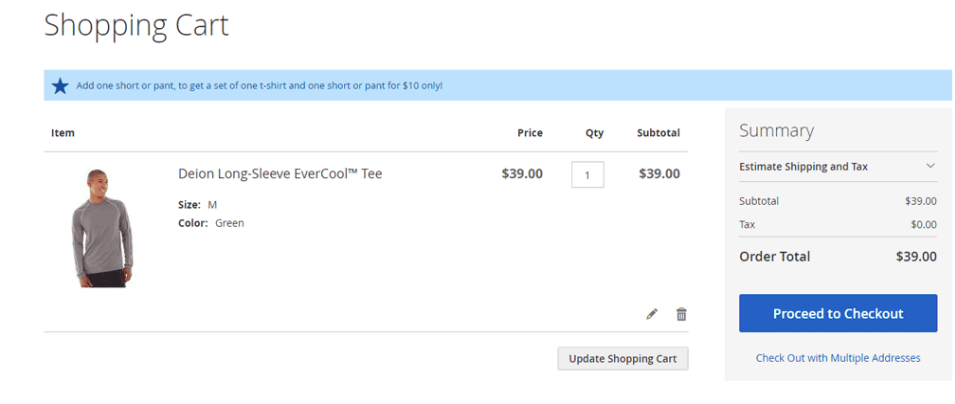Bundle: Buy A + B + C + D for …
This promotion applies a discount or a fixed price on products that are purchased together, as a bundle. This promotion is commonly used to encourage the customer to buy the whole set of items that go together with the item that interests him.
If you are looking for advanced features of the bundled discount promotion, please take a look at the Bundled Discount extension. It allows to display the products of the bundle in various site pages, and makes it possible for the customer to add all bundle parts directly from there.
Promo examples:
- Buy a jacket, pair of pants and a t-shirt for $100
- If you buy a washer and a drier, you get a 10% discount on the order
Configuration
In the actions list, we have the "Bundle: Buy A + B + C + D for …" action type -
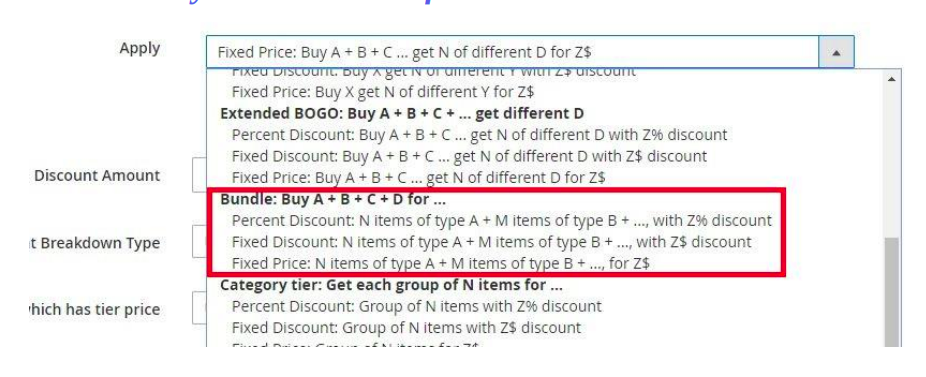
Once selected, the following fields will show up -
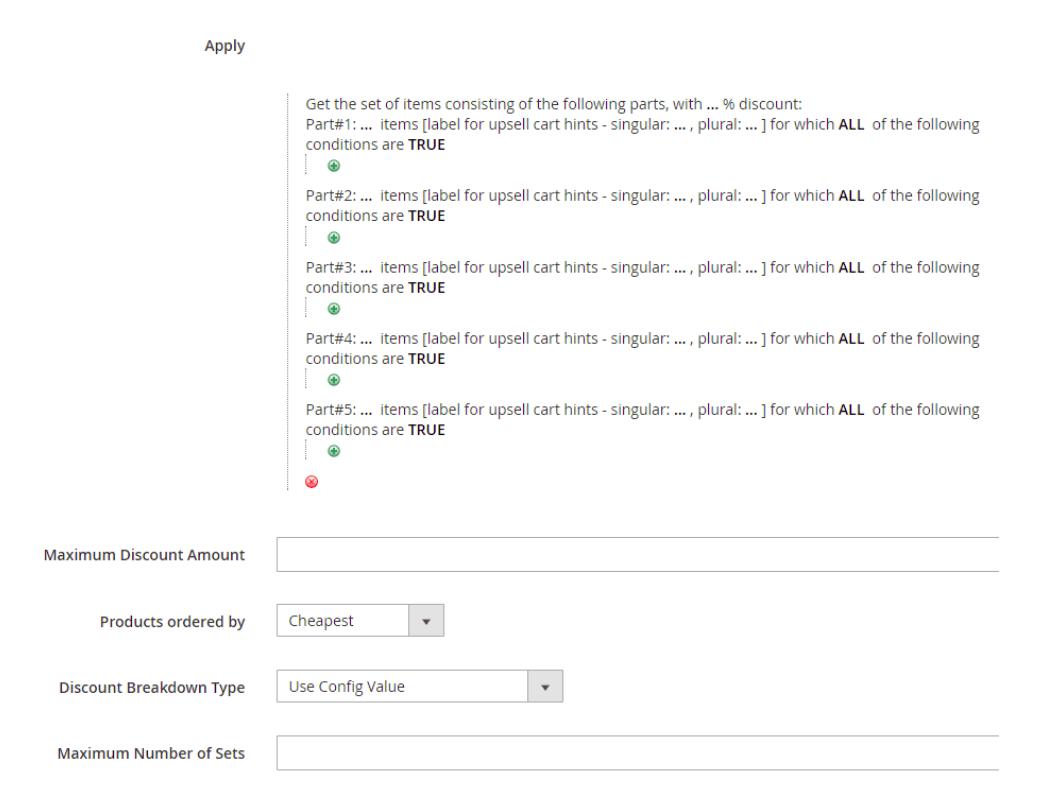
Fields explanation
- Get the set of items consisting of the following parts, with … % discount – the discount percent that one will get for the A + B + C set.
- Part#1: … items – number of items in part#1 (A)
- Part#2: … items – number of items in part#2 (B)
- Part#3: … items – number of items in part#3 (C)
- Part#1: … items label for cart hints – singular / plural – the name that will show up in the cart hints, representing the “Part #1” (A) items.
- Part#2: … items label for cart hints – singular / plural – the name that will show up in the cart hints, representing the “Part #2” (B) items.
- Part#3: … items label for cart hints – singular / plural – the name that will show up in the cart hints, representing the “Part #3” (C) items.
- Items for which ALL of the following conditions are TRUE [parts] – the condition that defines the items of the specific part.
- Maximum Discount Amount – maximum discount amount that customer can get in his cart using this promotion
- Products ordered by (cheapest / most expensive) – the items order by which the promotion discount will get applied
- Maximum number of sets – the maximum number of sets that the discount will be applied on.
The A, B, C item groups should be different, that is, their conditions shouldn’t collide. Otherwise, the promotion wouldn't work properly.
Bundled Discount – Percent Discount
Example
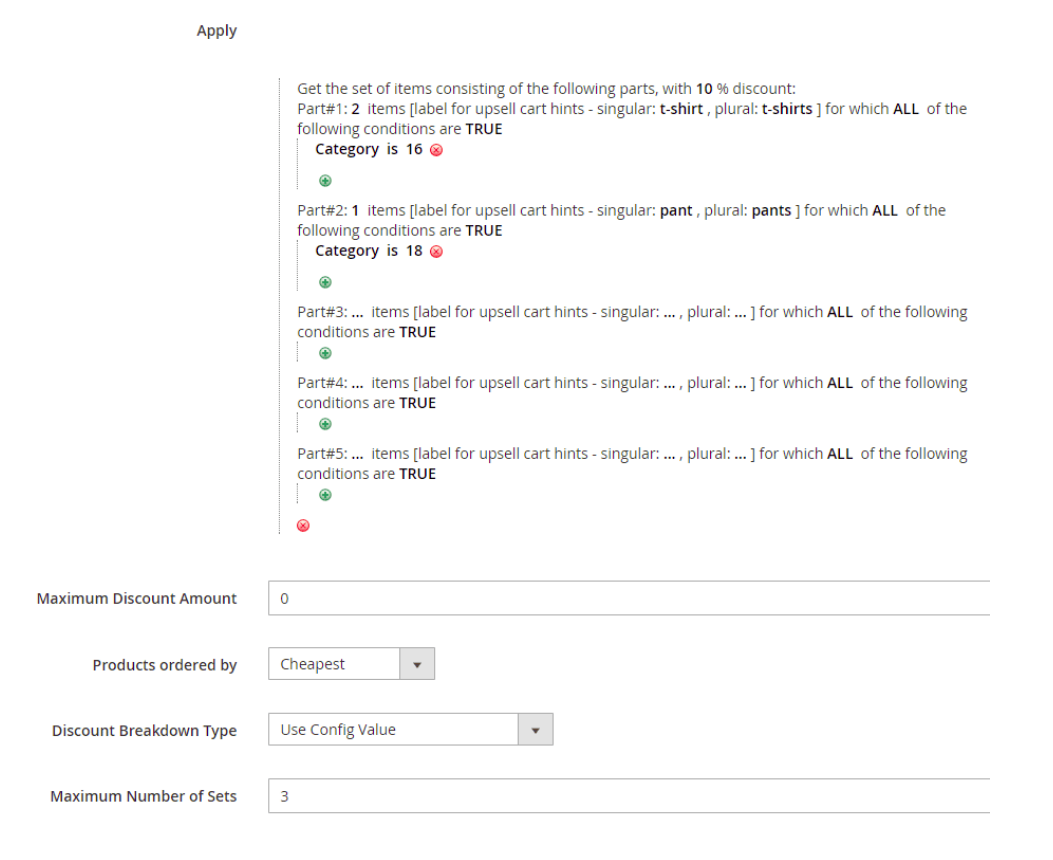
The rule in this example is – “10% discount on buying 2 T-shirts and 1 pant”. Maximum number of discounted sets per order is 3.
Note: In our example, T-Shirt is any product that belongs to category 16 and pant is any product that belongs to category 18.
Cart examples for this rule:
- Customer has 1 T-shirt (10$), 2 T-shirts (20$ each), 1 T-shirt (25$), 1 pant (30$) in cart. The discount amount is 6$ (10% out of 10$ + 20$ + 30$)
- Customer has 8 T-shirts (10$ each) and 4 pants (20$ each). The discount amount is 12$. (10% out of 6x10$+3x20$). The “Maximum number of sets” limited the number of sets here to 3 (otherwise the number of sets would be 4 and the discount amount would be 10% out of 8x10$+4x20$).
Upsell cart hints example for this rule:
- Customer has 1 bag in cart. The upsell cart hint is “Add 2 t-shirts and one pant, to get a set of 2 t-shirts and one pant with 10% discount!”
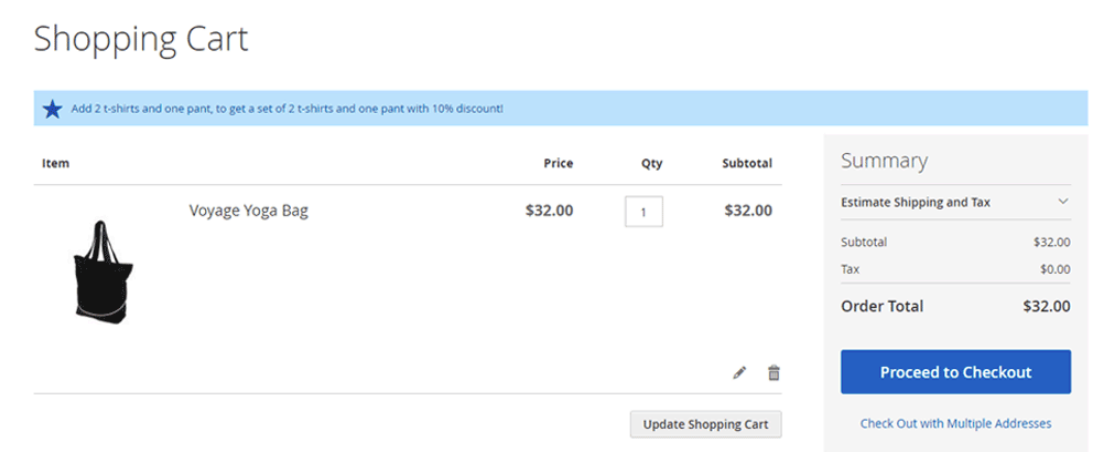
- Customer has 1 t-shirt and 1 pant in cart. The upsell cart hint is “Add one more t-shirt, to get a set of 2 t-shirts and one pant with 10% discount!”
Bundle – Fixed Discount
Example
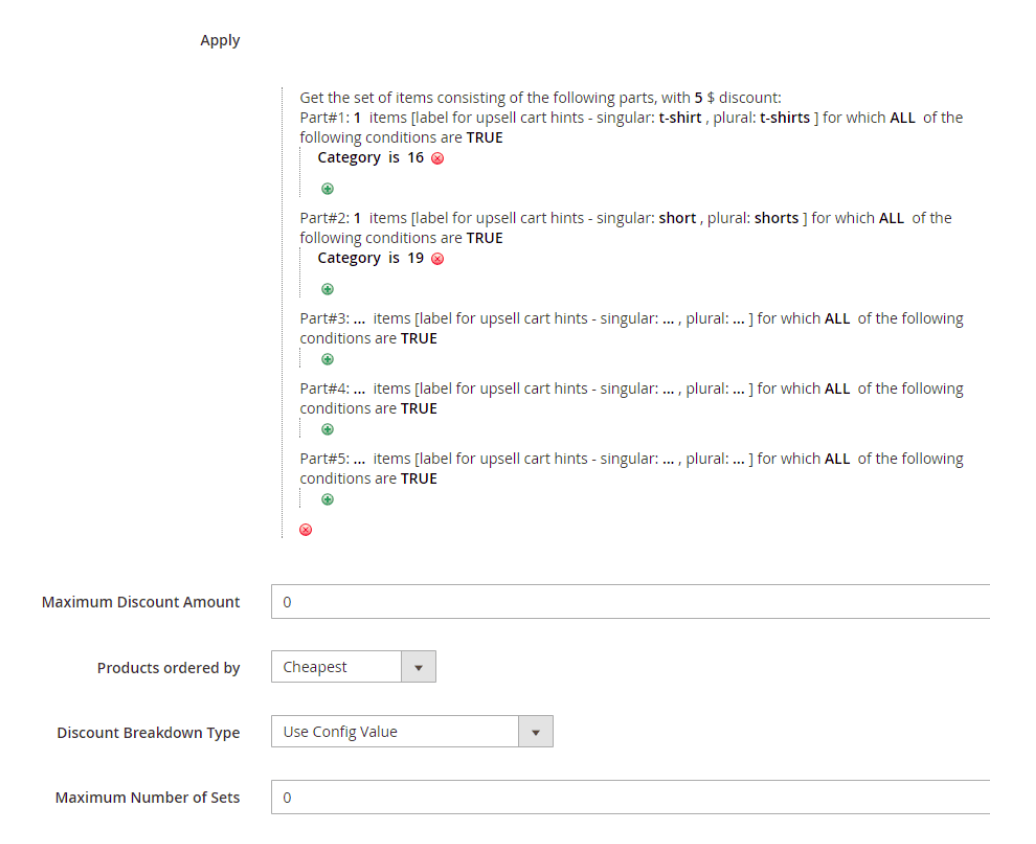
The rule in this example is – “Get 5$ discount for each pair of T-shirt + Short”.
Note: In our example, T-Shirt is any product that belongs to category 16 and short is any product that belongs to category 19.
Cart examples for this rule:
- Customer has 1 T-shirt (10$), 1 short (15$). The discount amount is 5$
- Customer has 2 T-shirts (10$), 1 short (15$) and 2 shorts (20$ each). The discount amount is 10$. (There are 2 sets of T-shirt + short)
Upsell cart hints example for this rule:
- Customer has 1 t-shirt in cart. The upsell cart hint is “Add one short, to get a set of one t-shirt and one short with $5 discount!”
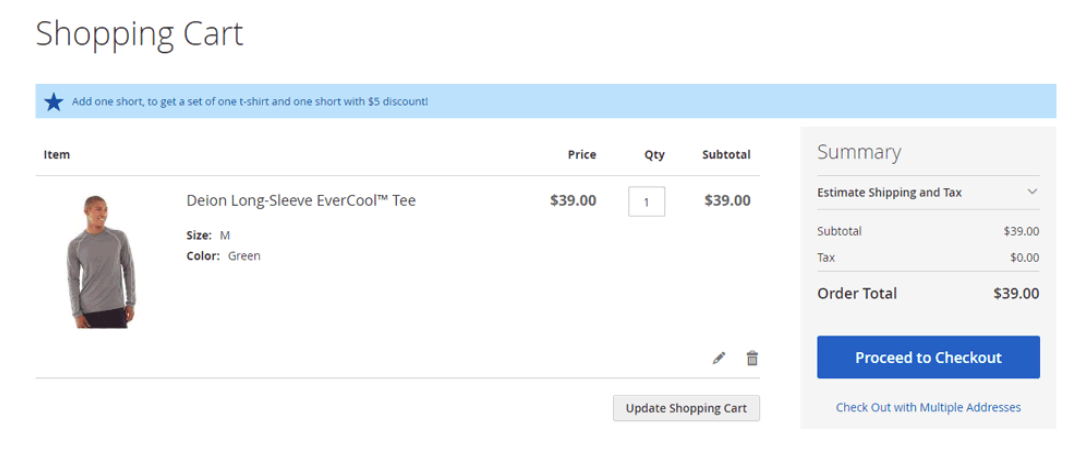
Bundle – Fixed Price
Example
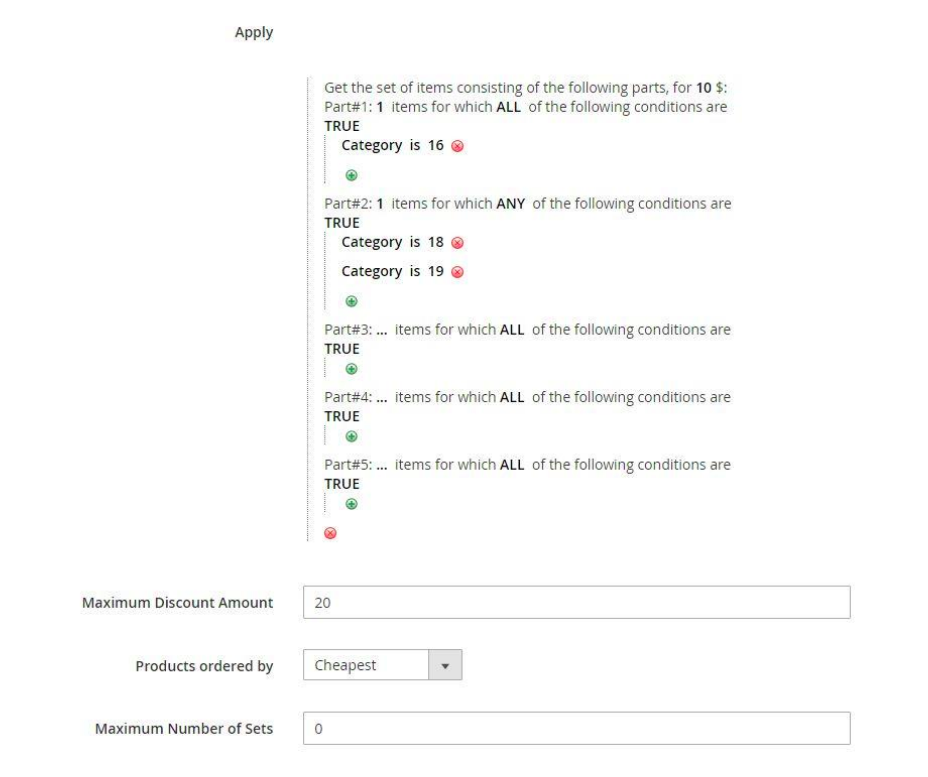
The rule in this example is – “Get T-shirt + pants or shorts for 10$”. Maximum discount amount is 20$.
Note: In our example, T-Shirt is any product that belongs to category 16, pant is any product that belongs to category 18 and short is any product that belongs to category 19.
Cart examples for this rule:
- Customer has 1 T-shirt (10$), 1 short (15$). The discount amount is 15$. (Because it cost the customer 10$ instead of 25$)
- Customer has 2 T-shirts (10$ each), and 2 shorts (15$ each). The discount amount is 15$ (Because it costs the customer 10$ instead of 25$). (The “Maximum discount amount” is 20$, therefore the discount only applied to one set of T-shirt+shorts).
Upsell cart hints example for this rule:
- Customer has 1 t-shirt in cart. The upsell cart hint is “Add one short or pant, to get a set of one t-shirt and one short or pant for $10 only!”
